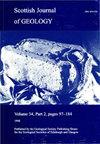苏格兰和爱沙尼亚中泥盆世球藻类生物地层
IF 0.5
4区 地球科学
Q4 GEOLOGY
引用次数: 7
摘要
爱沙尼亚中泥盆纪Tamme Cliffs地区的一块尾骨被描述为Dickosteus cf.shreiplandi,D.threiplandi是苏格兰Orcadian盆地中泥盆世的一个常见物种。塔姆悬崖上的许多其他骨头也被归入该属。众所周知,这两个地区都有尖尾球虫和可能的小Millerosteus。最后一个尾骨属Watsonosteus先前已被证明也存在于这两个地区。我们可以确认,Orcadian盆地和爱沙尼亚的尾骨属序列是相同的,从最低层来看,是Coccosteus–Dickosteus–Millerosteus–Watsonosteus。爱沙尼亚的尾骨类也与其他苏格兰动物群元素(包括共特异性物种)有关,如其他板足目、棘足目和肌翅目。这意味着中泥盆纪这两个地区之间有着非常密切的联系。Orcadian盆地的一些棘突类物种也存在于白俄罗斯和Severnaya Zemlya,这表明其他Orcadian流域形式,包括尾骨类,可能存在于这些地方,也可能存在于旧红砂岩大陆的其他地方。进一步的调查可能会在整个大陆的物种水平上实现全大陆的相关性。本文章由计算机程序翻译,如有差异,请以英文原文为准。
Middle Devonian coccosteid (Arthrodira, Placodermi) biostratigraphy of Scotland and Estonia
A coccosteid nuchal bone from the Middle Devonian Tamme Cliffs locality in Estonia is described as Dickosteus cf. threiplandi, D. threiplandi being a common species in the Middle Devonian of the Orcadian Basin, Scotland. A number of other bones from Tamme Cliffs are also placed in this genus. It is already known that the coccosteids Coccosteus cuspidatus and probably Millerosteus minor are present in both areas. A final coccosteid genus Watsonosteus has been shown previously to also be present in both areas. We can confirm that the sequence of coccosteid genera is the same in both the Orcadian Basin and Estonia and is, from the lowest horizon, Coccosteus–Dickosteus–Millerosteus–Watsonosteus. The coccosteids in Estonia are also associated with other Scottish faunal elements (including co-specific species), such as other placoderms, acanthodians and sarcopterygians. This implies a very close connection between the two areas in the Middle Devonian. Some of the acanthodian species of the Orcadian Basin are also present in Belarus and Severnaya Zemlya, suggesting that other Orcadian Basin forms, including coccosteids may be present at these localities and perhaps elsewhere on the Old Red Sandstone continent. Further investigation may allow a continent-wide correlation at species level across the whole continent.
求助全文
通过发布文献求助,成功后即可免费获取论文全文。
去求助
来源期刊

Scottish Journal of Geology
地学-地质学
CiteScore
1.70
自引率
0.00%
发文量
10
审稿时长
>12 weeks
期刊介绍:
Although published only since 1965, the Scottish Journal of Geology has a long pedigree. It is the joint publication of the Geological Society of Glasgow and the Edinburgh Geological Society, which prior to 1965 published separate Transactions: from 1860 in the case of Glasgow and 1863 for Edinburgh.
Traditionally, the Journal has acted as the focus for papers on all aspects of Scottish geology and its contiguous areas, including the surrounding seas. The publication policy has always been outward looking, with the Editors encouraging review papers and papers on broader aspects of the Earth sciences that cannot be discussed solely in terms of Scottish geology.
The diverse geology of Scotland continues to provide an important natural laboratory for the study of earth sciences; many seminal studies in geology have been carried out on Scottish rocks, and over the years the results of much of this work had been published in the Journal and its predecessors.
The Journal fully deserves its high reputation worldwide and intends to maintain its status in the front rank of publications in the Earth sciences.
 求助内容:
求助内容: 应助结果提醒方式:
应助结果提醒方式:


